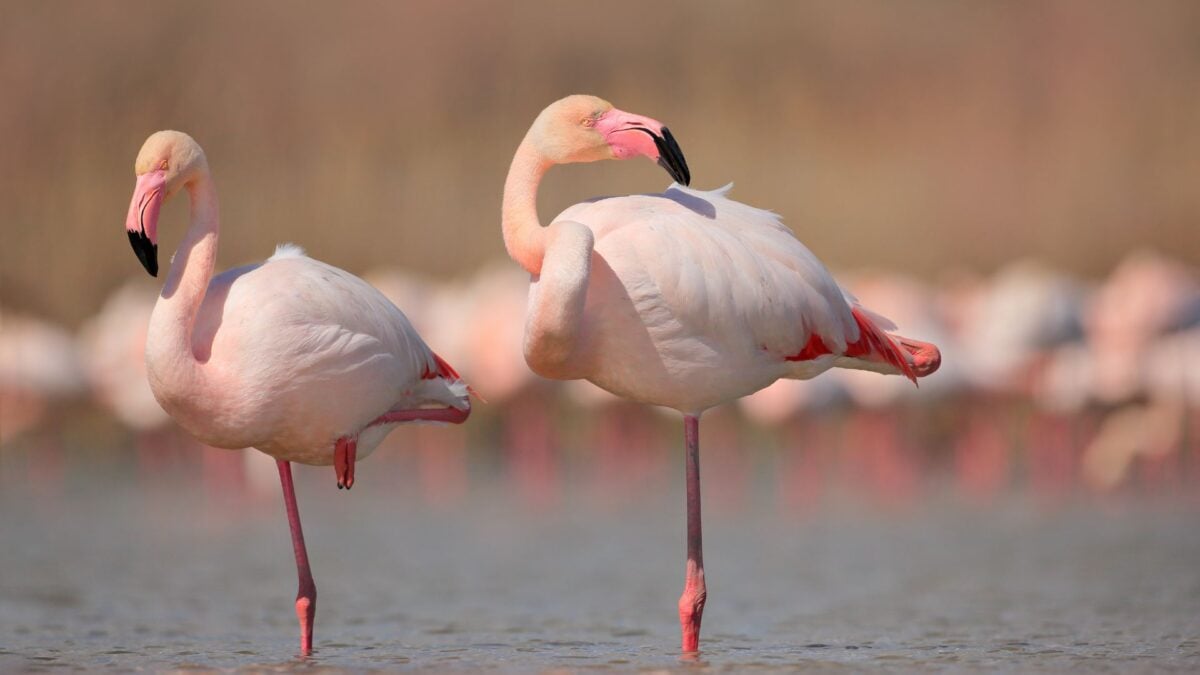Despite the uniform appearance of pink flamingo flocks, individuals live very different lifestyles. In the Camargue region of France, some stay put for their entire lives while others migrate along the Mediterranean coast. Now, scientists believe these two groups differ in how they age, too.
New research published Monday, August 25, in the journal PNAS found that migratory flamingoes, who leave the Camargue annually to spend the winter in Italy, Spain, or North Africa, age slower than non-migratory resident flamingoes.
The findings point to a link between migratory behavior and the rate of aging, adding a new layer of complexity to one of the most central—and perplexing—questions in biology: why do living creatures feature an expiration date? And why do these expiration dates vary so widely among different species? New research adds yet another layer of complexity to these questions.
“Understanding the causes of changes in the rate of aging is a problem that has obsessed researchers and polymath philosophers since ancient times,” co-author Hugo Cayuela, a postdoctoral researcher at the University of Oxford, said in a release. “For a long time, we thought that these variations occurred mainly between species. But recently, our perception of the problem has changed,” he added.
Same species, different lifestyle—and lifespan
Mounting evidence suggests that individuals within the same species often do not age at the same rate due to genetic, behavioral, or environmental variation, according to Cayuela. Studying these differences can help scientists unlock the secrets of aging. Thanks to their long lifespans and behavioral diversity, the Camargue’s greater flamingoes provide an ideal model for this research.
Cayuela and his colleagues analyzed more than 40 years of data gathered by the Tour du Valat research institute’s flamingo tagging and tracking program. These data described mortality and reproductive patterns among 1,840 migrating and non-migrating greater flamingos across the Mediterranean basin. Resident individuals exhibited lower mortality rates in early adulthood than migrating individuals, resulting in life expectancies that were 6.7 years longer on average.
Migratory greater flamingoes, however, exhibited 40% slower aging and reduced mortality later in life than residents. In fact, the findings suggest that aging begins a year and a half earlier in resident greater flamingoes than migrants.
The researchers also uncovered differences in reproductive patterns between migratory and nonmigratory greater flamingoes. While residents had higher probabilities of breeding than migrants before the onset of aging, they exhibited much steeper declines in breeding with age compared to migrants.
“While residents can reproduce more often early in life, this comes at a cost: higher mortality and reduced reproductive success later on,” co-author Jocelyn Champagnon, a research scientist at Tour du Valat, told Gizmodo in an email. “Migrants, on the other hand, may trade off some early reproduction for better survival later in life.”
Behavior shapes biology
These differences are “probably linked to a compromise between performance when young and health in old age,” co-author Sébastien Roques, a postdoctoral researcher at the French National Center for Scientific Research, said in the release. “Residents live intensely at first, but pay for this pace later on. Migrants, on the other hand, seem to age more slowly.”
Together, these findings suggest that migrating comes with some disadvantages early in life but reduces the rate of aging and reproductive senescence—the age-related decline in an individual’s ability to reproduce—later in life. According to the researchers, this study highlights the critical role that migration plays in shaping survival and reproduction throughout life, underscoring the importance of behavioral decisions in the biology of aging.
“Our study shows that the shape and pace of aging can be shaped by individual decisions early in life, such as migration or early reproduction,” Champagnon said. Though these results can’t be directly applied to people, she hopes future studies will address questions about how human migrations influence the rate of aging.
